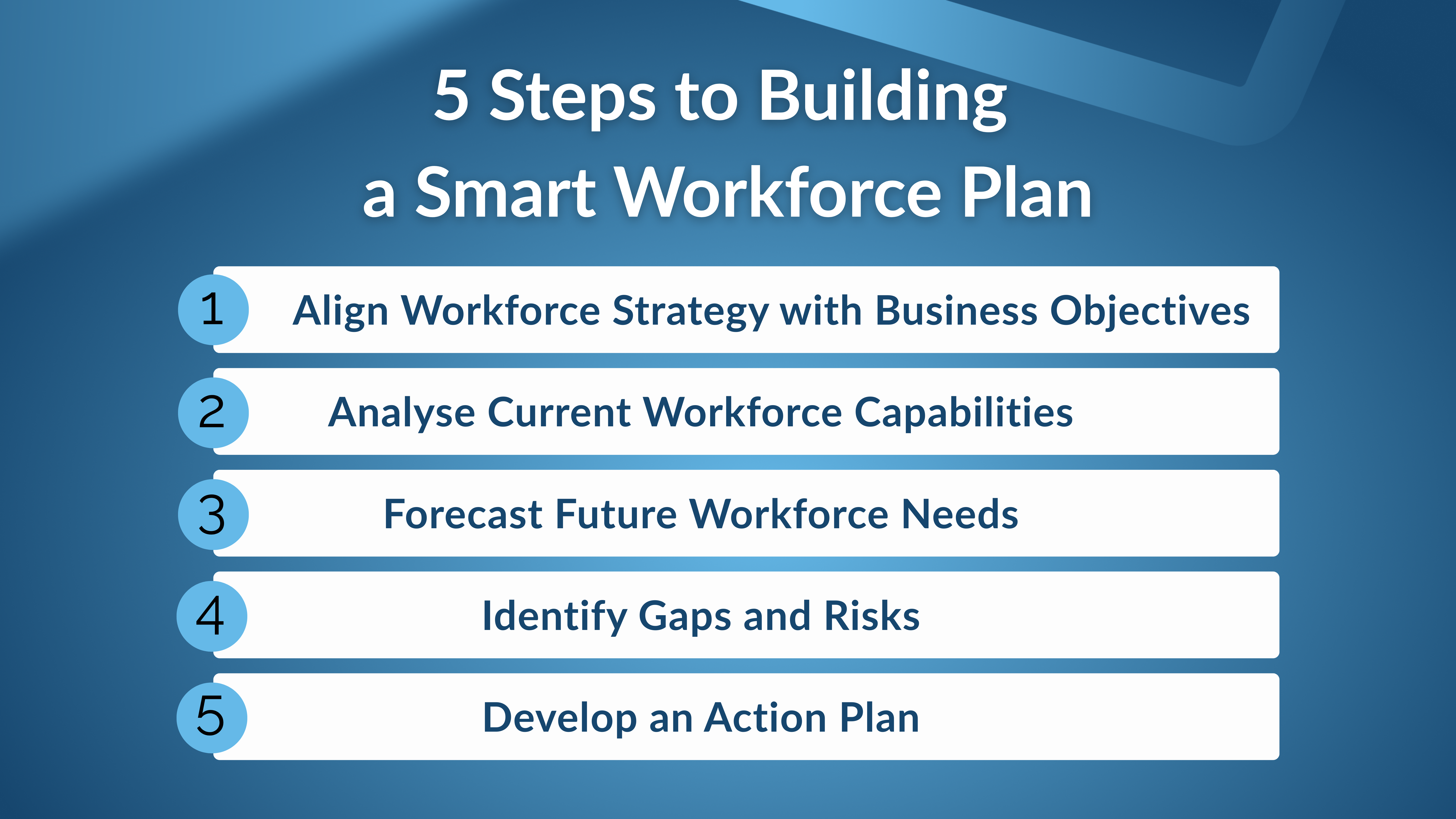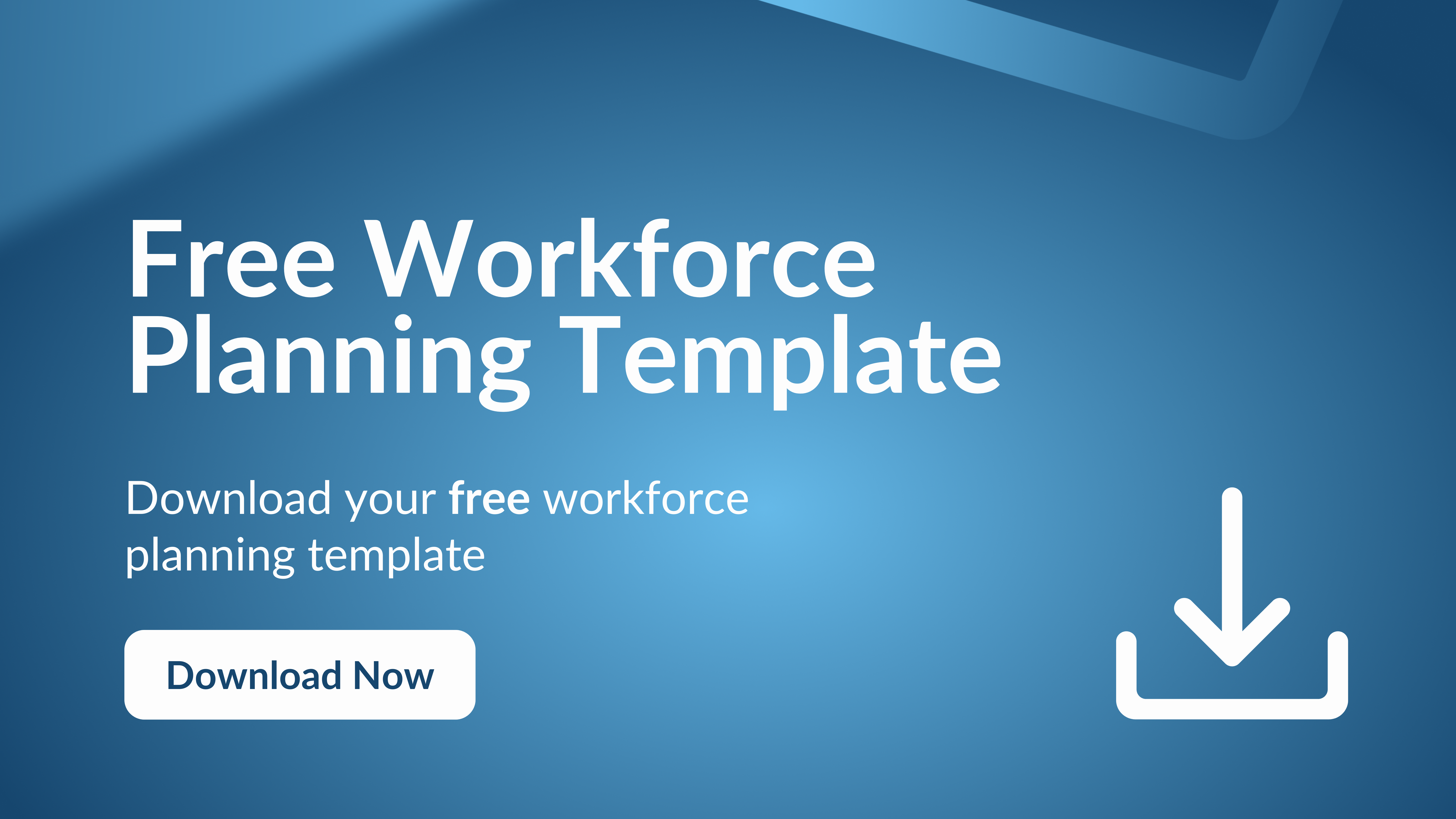Business success isn't solely about having the best product or service; it's about having the right people with the right skills, and keeping them. Yet, many companies find themselves in a constant cycle of reactive hiring - hurrying to fill unexpected vacancies, struggling with skill gaps, and watching costs rise out of control.
What if you could move from a reactive state to a proactive one? What if you could anticipate your future talent needs with confidence and build a team that is aligned with your long-term business goals?
This is where strategic workforce planning comes in. It's the crucial link between your business strategy and your talent strategy, providing a clear roadmap to ensure your organisation is ready for whatever the future may bring. This guide will outline what workforce planning is, why it's essential for success and business continuity, and how to develop a smart plan that will future-proof your business.
What Is Workforce Planning and Why Does It Matter?
Workforce planning is the strategic process of analysing your current workforce and forecasting your future talent needs to ensure you have the right people to achieve your business objectives. It's not just about filling open roles; it's about understanding where your company is going and designing a workforce that can take you there. The core components of workforce planning include:
-
Workforce Analysis: Assessing the skills, roles, and demographics of your current employees.
-
Demand Analysis: Forecasting the talent and skills your business will need in the future in order to reach your business goals.
-
Gap Analysis: Identifying the missing pieces that your current talent needs in order to meet your future demands.
- Action Planning: Developing strategies to close those gaps through training, upskilling or recruitment.

Common Workforce Planning Challenges
Without a solid plan, many organisations face common issues that hurt their growth and stability. Recognising these challenges is the first step to overcoming them.
-
Reactive vs. Proactive Hiring: A key challenge is working in "firefighting" mode. When a key employee resigns, the search for a replacement begins in a panic. This reactive cycle is costly, time-wasting, and often results in poor hiring choices made under pressure.
-
Lack of Visibility into Future Talent Needs: Many leaders focus on immediate demands and overlook the skills needed in two, three, or five years.
-
Misalignment Between HR and Business Goals: When HR is not involved at leadership level, efforts may not align with the company's strategic direction. Workforce planning bridges this gap, ensuring that every talent decision driven by HR supports core business objectives.
- Internal Strain and Burnout: Equally important is the risk of overloading existing staff because of poor planning. This can quickly spiral into burnout, high turnover, and the loss of valuable knowledge. Good workforce planning isn't just about hiring; it's about creating a stable, sustainable, and healthier workplace culture in order to retain and up-skill the current workforce.
5 Steps to Building a Smart Workforce Plan
Creating a strong workforce plan can be simple. Follow these five steps to align your talent with your goals.

1. Align Workforce Strategy with Business Objectives
First, know where your business is going. Ask important questions:
- What are our strategic goals for the next 1-3 years (e.g., entering a new market or launching a product)?
- What technology trends will affect our industry?
- What talent and skills do we need to achieve these goals?
This step ensures your talent strategy is synched well to drive the business in the direction set out.
2. Analyse Current Workforce Capabilities
Next, take a deeper look at your current workforce. Run a talent audit or create a skills inventory. Collect data on:
- Headcount and Demographics: Who is on your team and what are their roles?
- Skills and Competencies: What key skills do your employees have? Where are the strengths and weaknesses?
- Performance and Potential: Who are your top performers? Who shows future leadership potential?
This analysis reveals what you have to work with.
3. Forecast Future Workforce Needs
Now, think about the future. Based on your business goals, forecast your talent requirements. Consider:
- New Roles: What new positions will you need?
- Evolving Roles: How will current roles change? What new skills will be required?
- Redundant Roles: Are there roles that may become outdated?
Use trend analysis and scenario planning to make smart predictions.
4. Identify Gaps and Risks
Now, compare your current workforce (Step 2) with your future needs (Step 3). This gap analysis will show where you need to focus. You might find:
- Skill Gaps: You need more data scientists, but your team lacks those skills.
- Succession Gaps: Key positions are held by people nearing retirement, with no clear successors.
- Quantity Gaps: You may need to increase your sales team by 20% to meet targets.
This step helps clarify your priorities.
5. Develop an Action Plan
Finally, create a clear action plan to address the gaps you found. Your plan should include specific strategies, timelines, and responsibilities. Common actions might be:
- Recruitment (Buy): Hire new talent to bring in fresh skills.
- Training & Development (Build): Upskill your current employees.
- Contracting (Borrow): Use freelancers for specific projects.
- Retention: Implement programmes to keep your top performers motivated.
The Role of Recruitment in Workforce Planning
A workforce plan is only as good as its execution, and this is where strategic recruitment comes in. For a plan to succeed, recruitment can't be an afterthought; it needs a seat at the strategic table.
By involving a recruitment partner like Konnekt in your planning process, you transform hiring from a reactive necessity into a strategic advantage. An expert partner can help you:
Build Talent Pipelines in Advance: Instead of starting from scratch for every open role, you can proactively build relationships with high-potential candidates for your most critical positions. From a recruiter’s perspective, this is where proactive planning makes the biggest difference, especially for hard-to-recruit roles. When companies plan ahead, recruiters can dedicate time to running multiple searches, networking, and assessing candidates for both technical ability and cultural alignment. The benefit for clients is huge: they save time, reduce the stress of last-minute hiring, and gain confidence that their growth plans are backed by a pool of qualified, interested talent ready to engage.
Gain Market Intelligence: Recruiters have deep insights into the talent market, including salary benchmarks, skill availability, and competitor activity. This intelligence is invaluable for making realistic and effective workforce plans.
Meet Long-Term Goals: A strategic recruitment partner understands that they aren't just filling a job; they are helping you build the team you need for the future. They can work with you to find candidates who not only have the right skills today but also have the potential to grow with your company.
Meet Long-Term Goals by Seizing Opportunities: A strategic recruitment partner can help you build the team you need for the future by finding candidates with the potential to grow with your company. A trusted partner who deeply understands your culture and environment will naturally keep an eye out for exceptional individuals, even when you aren't actively hiring. For example, a tech candidate in the payments industry was recently introduced by Konnekt to a company this way. The company was so impressed they created a new role for him, which is now allowing them to diversify their operations and offer clients something innovative.
In another recent success story, a company building its capabilities in AI was able to recruit multiple developers to support its future-facing goals. This recruitment drive was based entirely on long-term workforce planning, not immediate vacancies, proving how forward-thinking strategy and modern recruitment go hand in hand to keep a company ahead of the curve.
Workforce Planning in Action: Download a Free Template
To help you get started, we've designed a simple template that guides you through the core components of workforce planning. It includes dedicated sections for:
Current Workforce Profile: Documenting your existing roles and headcount.
Skills Inventory: Mapping the key skills across your team.
Future Demand Forecast: Projecting your talent needs based on business goals.
Gap Analysis & Action Plan: Identifying critical gaps and outlining your strategy to close them.

Best Practices for Long-Term Success
Workforce planning is a continuous process, not a one-time task. To ensure lasting success, follow these best practices:
Make it Continuous: The business world changes fast. Update your workforce plan quarterly or annually to keep it relevant.
Collaborate Across Departments: Involve leaders from finance, operations, and other key areas in planning. Their insights create a complete and accurate plan.
Review and Adjust Regularly: Monitor your progress with the action plan. Are your recruitment efforts on track? Is your training programme providing the right skills? Be ready to change your strategy based on what works and what doesn’t.
Build Strategic Recruitment Partnerships: Collaborate closely with recruiters who know your company culture and long-term plans. Embrace a modern, flexible approach and stay open to great talent even if you don’t have an immediate vacancy.
Balance Internal and External Talent: Look after the people already in your company. Good workforce planning balances bringing in the right external talent with retaining and supporting existing employees to ensure sustainable growth and stability.
The key is to move from a reactive to a proactive mindset. By embracing a structured workforce planning process, you can ensure your most valuable asset, your people, is your greatest competitive advantage.
Ready to start building your future-proof team? Download our free workforce planning template and take the first step toward strategic talent management. Download your free workforce planning template now
Author: Janine Anton, Tech Recruiter, motivated and passionate, with a personal mission to help people and support them in achieving long-term career growth.
